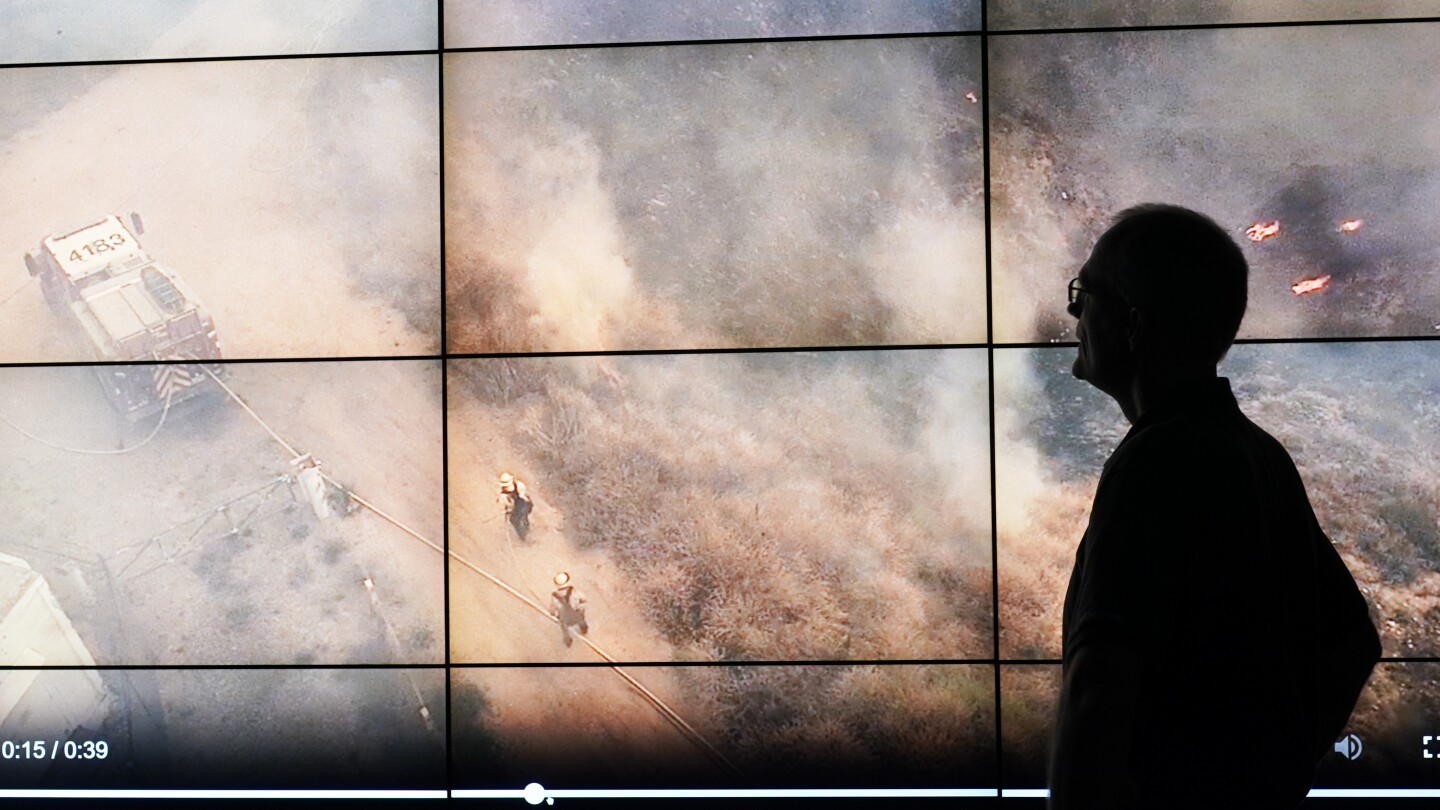LONDON (AP) — Wildfires fueled by climate change have ravaged communities from Maui to the Mediterranean this summertime, killing numerous people today, exhausting firefighters and fueling demand for new options. Enter synthetic intelligence.
Firefighters and startups are utilizing AI-enabled cameras to scan the horizon for signs of smoke. A German corporation is building a constellation of satellites to detect fires from space. And Microsoft is using AI designs to predict where the subsequent blaze could be sparked.
With wildfires getting to be larger and extra extreme as the environment warms, firefighters, utilities and governments are scrambling to get ahead of the flames by tapping into the most up-to-date AI technology — which has stirred both of those anxiety and excitement for its likely to transform daily life. Even though ever more stretched initially responders hope AI presents them a leg up, individuals are however required to look at that the tech is precise.
California’s main firefighting company this summertime begun screening an AI process that seems to be for smoke from more than 1,000 mountaintop digicam feeds and is now expanding it statewide.
The technique is developed to come across “abnormalities” and alert crisis command centers, in which staffers will affirm no matter whether it’s certainly smoke or a thing else in the air.
“The splendor of this is that it promptly pops up on the display screen and people dispatchers or connect with takers are ready to interrogate that screen” and determine irrespective of whether to send a crew, reported Phillip SeLegue, staff members chief of intelligence for the California Division of Forestry and Fireplace Defense.
The cameras, portion of a community that staff previously experienced to observe, give billions of bytes of info for the AI system to digest. While individuals still will need to affirm any smoke sightings, the method assists decrease fatigue amongst staffers typically checking a number of screens and cameras, alerting them to look only when there is attainable hearth or smoke, SeLegue stated.
It’s currently aided. A battalion chief received a smoke notify in the middle of the night time, confirmed it on his cellphone and named a command center in San Diego to scramble initial responders to the distant area.
The dispatchers mentioned that if they hadn’t been alerted, the hearth would have been considerably bigger since it most likely wouldn’t have been found till the future early morning, SeLegue mentioned.
San Francisco startup Pano AI usually takes a identical approach, mounting cameras on cell towers that scan for smoke and notify consumers, which include fireplace departments, utility providers and ski resorts.
The cameras use laptop eyesight machine finding out, a type of AI.
“They’re properly trained pretty specially to detect smoke or not, and we coach them with photographs of smoke and photographs of not smoke,” CEO Sonia Kastner mentioned.
The photographs are blended with feeds from govt temperature satellites that scan for hotspots, alongside with other details sources, this sort of as social media posts.
The know-how will get close to just one of the principal challenges in the classic way of detecting wildfires — relying on 911 phone calls from passers-by that need confirmation from staffers ahead of crews and drinking water-dropping planes can be deployed.
“Generally, only one particular in 20 of these 911 calls are truly a wildfire. Even through fireplace season, it may be a cloud or fog or a barbecue,” Kastner claimed.
Pano AI’s units do still rely on ultimate confirmation, with supervisors participating in a time lapse of the digital camera feed to be certain it’s smoke increasing.
For battling forest fires, “technology is becoming seriously important,” reported Larry Bekkedahl, senior vice president of electricity shipping at Portland Common Electric powered, Oregon’s greatest utility and a Pano AI shopper.
Utility corporations from time to time enjoy a role in sparking wildfires, when their electricity traces are knocked down by wind or struck by slipping trees. Hawaii’s electric utility acknowledged that its electric power traces commenced a devastating blaze in Maui this summer season soon after seemingly staying downed by high winds.
PGE, which provides electric power to 51 metropolitan areas in Oregon, has deployed 26 Pano AI cameras, and Bekkedahl said they have assisted pace up response and coordination with crisis services.
Previously, hearth departments were being “running all over searching for stuff and not even definitely understanding precisely in which it is at,” he explained. The cameras help detect fires more quickly and get groups on the ground speedier, shaving up to two hours off reaction moments.
“That’s sizeable in conditions of how rapid that fireplace can can unfold and increase,” Bekkedahl said.
Applying AI to detect smoke from fires “is comparatively quick,” said Juan Lavista Ferres, main information scientist at Microsoft.
“What is not quick is to have enough cameras that include ample sites,” he explained, pointing to wide, distant locations in northern Canada that have burned this summer season.
Ferres’ crew at Microsoft has been producing AI designs to predict where fires are possible to commence. They have fed the design with maps of spots that burned earlier, alongside with weather and geospatial knowledge.
The system has its limitations — it just cannot predict random activities like a lightning strike. But it can sift by historic weather conditions and local climate info to identify patterns, these types of as spots that are usually drier. Even a street, which signifies men and women are close by, is a danger variable, Ferres said.
“It’s not heading to get it all properly correct,” he explained. “But what it can do is it can construct a likelihood map (centered on) what occurred in the earlier.”
The engineering, which Microsoft options to offer you as an open up resource instrument, can assist initially responders seeking to determine out the place to aim their confined resources, Ferres said.
Yet another company is wanting to the heavens for a solution. German startup OroraTech analyzes satellite visuals with synthetic intelligence.
Getting benefit of improvements in digital camera, satellite and AI engineering, OroraTech has launched two mini satellites about the dimensions of a shoebox into minimal orbit, about 550 kilometers (340 miles) over Earth’s surface. The Munich-based corporation has ambitions to ship up 8 more up coming yr and sooner or later set 100 into space.
As wildfires swept central Chile this year, OroraTech said it offered thermal visuals at evening when aerial drones are employed considerably less regularly.
Months immediately after OroraTech launched its second satellite, it detected a fireplace close to the group of Keg River in northern Alberta, the place flames burned remote stretches of boreal forest continuously this summer months.
“There are algorithms on the satellite, quite efficient kinds to detect fires even quicker,” CEO Thomas Gruebler said.
The AI also will take into account vegetation and humidity concentrations to determine flare-ups that could spawn devastating megafires. The technology could aid thinly stretched firefighting organizations immediate resources to blazes with the opportunity to induce the most harm.
“Because we know just the place the fires are, we can see how the fires will propagate,” Gruebler reported. “So, which hearth will be the huge fireplace in just one day and which will halt on their possess.”
___
AP Engineering Author Barbara Ortutay in San Francisco contributed.





